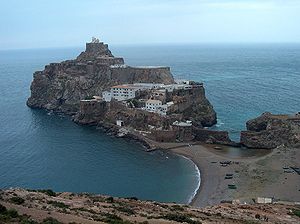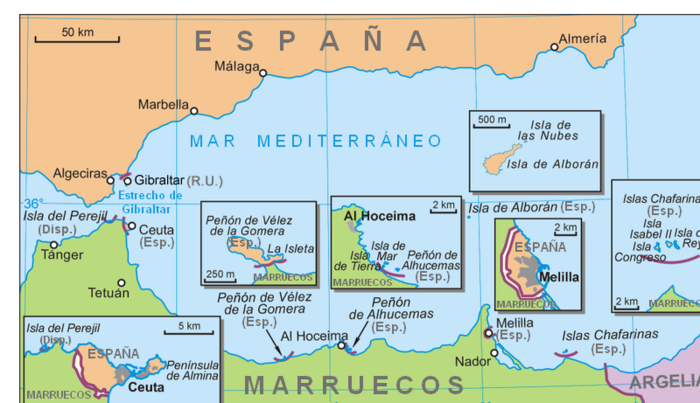
Peñón de Vélez de la Gomera
Encyclopedia

Spain
Spain , officially the Kingdom of Spain languages]] under the European Charter for Regional or Minority Languages. In each of these, Spain's official name is as follows:;;;;;;), is a country and member state of the European Union located in southwestern Europe on the Iberian Peninsula...
rock in North Africa off the Moroccan
Morocco
Morocco , officially the Kingdom of Morocco , is a country located in North Africa. It has a population of more than 32 million and an area of 710,850 km², and also primarily administers the disputed region of the Western Sahara...
coast (Plazas de soberanía). It is part of several Peñones
Peñón
A Peñón is a term for certain offshore island forts established by the Spanish Empire . Several are still part of the plazas de soberanía of Spain in Northern Africa.-History:...
, or rock-fortresses on the coast of Northern Africa. Vélez de la Gomera is administered from Melilla
Melilla
Melilla is a autonomous city of Spain and an exclave on the north coast of Morocco. Melilla, along with the Spanish exclave Ceuta, is one of the two Spanish territories located in mainland Africa...
. Its tiny population is made up of military personnel only.
Geography
Peñón de Vélez de la Gomera is located 119 km southeast of CeutaCeuta
Ceuta is an autonomous city of Spain and an exclave located on the north coast of North Africa surrounded by Morocco. Separated from the Iberian peninsula by the Strait of Gibraltar, Ceuta lies on the border of the Mediterranean Sea and the Atlantic Ocean. Ceuta along with the other Spanish...
. It was a natural island in the Alboran Sea
Alboran Sea
|300px|thumb|]]The Alboran Sea is the westernmost portion of the Mediterranean Sea, lying between Spain on the north and Morocco and Algeria on the south...
until 1934, when a huge thunderstorm washed large quantities of sand in the short channel between the island and the African continent Ever since, it has been a peninsula, currently connected to the Moroccan coast by an 85 m long sandy isthmus
Isthmus
An isthmus is a narrow strip of land connecting two larger land areas usually with waterforms on either side.Canals are often built through isthmuses where they may be particularly advantageous to create a shortcut for marine transportation...
, the world's shortest land border. With a length of 400 meters northwest-southeast and a width of up to 100 meters, it covers about 19,000 m² or 1.9 ha
Hectare
The hectare is a metric unit of area defined as 10,000 square metres , and primarily used in the measurement of land. In 1795, when the metric system was introduced, the are was defined as being 100 square metres and the hectare was thus 100 ares or 1/100 km2...
.
History

Portugal
Portugal , officially the Portuguese Republic is a country situated in southwestern Europe on the Iberian Peninsula. Portugal is the westernmost country of Europe, and is bordered by the Atlantic Ocean to the West and South and by Spain to the North and East. The Atlantic archipelagos of the...
and Spain
Spain
Spain , officially the Kingdom of Spain languages]] under the European Charter for Regional or Minority Languages. In each of these, Spain's official name is as follows:;;;;;;), is a country and member state of the European Union located in southwestern Europe on the Iberian Peninsula...
passed an agreement in 1496 in which they effectively established their zones of influence on the North Africa
North Africa
North Africa or Northern Africa is the northernmost region of the African continent, linked by the Sahara to Sub-Saharan Africa. Geopolitically, the United Nations definition of Northern Africa includes eight countries or territories; Algeria, Egypt, Libya, Morocco, South Sudan, Sudan, Tunisia, and...
n coast: Spain could only occupy territory east of Peñon de Velez. This restriction would only end with the absorption of Portugal into the Spanish crown of Philip II after the 1578 Battle of Ksar El Kebir, when Spain started to take direct actions in Morocco
Morocco
Morocco , officially the Kingdom of Morocco , is a country located in North Africa. It has a population of more than 32 million and an area of 710,850 km², and also primarily administers the disputed region of the Western Sahara...
, as in the occupation of Larache
Larache
Larache is an important harbour town in the region Tanger-Tétouan in northern Morocco. It was founded in the 7th century when a group of Muslim soldiers from Arabia extended their camp at Lixus onto the south bank of the Loukkos River.In 1471, the Portuguese settlers from Asilah and Tangier drove...
.
In 1508, Spain launched an expedition under the command of Pedro Navarro to fight against the pirates who populated it, and who were constantly attacking and looting the coast of Southern Spain. Spain captured the Peñón.
In 1522, Spain lost the Peñon after a successful Moroccan Berber attack, in which the whole Spanish garrison was slaughtered. Ali Abu Hassun
Ali Abu Hassun
Ali Abu Hassun, also Abu al Hasan Abu Hasun or Abu Hasun, full name Abu al-Hasan Abu Hasun Ali ibn Muhammad, was a Regent of the Crown of Morocco for the Wattasid dynasty, during the 16th century....
, new ruler of the Kingdom of Fez
Kingdom of Fez
The Kingdom of Fez or Wattasid sultanate was the name given to the northern part of Morocco between 1472 and 1554 with its capital at Fez.The Wattasid are a branch of the Zenete, a Berber clan whose origins lie in what is now modern day Libya....
in 1554, then gave the Penon to Ottoman
Ottoman Empire
The Ottoman EmpireIt was usually referred to as the "Ottoman Empire", the "Turkish Empire", the "Ottoman Caliphate" or more commonly "Turkey" by its contemporaries...
troops that had assisted him in gaining the throne.
In 1564, after a failed attempt in 1563, the Spaniards under command of García Álvarez de Toledo, 4th Marquis of Villafranca
García Álvarez de Toledo, 4th Marquis of Villafranca
García Álvarez de Toledo y Osorio, 4th Marquis of Villafranca del Bierzo , was a Spanish military officer and politician.- Biography :...
took the place from a garrison of 150 Ottoman
Ottoman Empire
The Ottoman EmpireIt was usually referred to as the "Ottoman Empire", the "Turkish Empire", the "Ottoman Caliphate" or more commonly "Turkey" by its contemporaries...
soldiers. Brantôme
Pierre de Bourdeille, seigneur de Brantôme
Pierre de Bourdeille, seigneur de Brantôme was a French historian, soldier and biographer.-Life:Brantôme was born in Périgord, Aquitaine, the third son of the baron de Bourdeille...
was a witness to the event. The Spanish have retained control of it ever since, despite having been besieged in 1680, 1701, 1755, 1781 and 1790.
In 1871, the Spanish Congress debated abandoning the Peñón, since by that time it had lost its military interest, but in the end the proposal was dropped.
External links
See also
- Plazas de soberaníaPlazas de soberaníaThe plazas de soberanía or sovereign territories, referred to in English as Spanish North Africa or simply Spanish Africa, are the current Spanish territories in continental North Africa bordering Morocco, except the autonomous cities of Ceuta and Melilla.After the Reconquista, forces of the...
- List of Spanish Colonial Wars in Morocco
- Spanish MoroccoSpanish MoroccoThe Spanish protectorate of Morocco was the area of Morocco under colonial rule by the Spanish Empire, established by the Treaty of Fez in 1912 and ending in 1956, when both France and Spain recognized Moroccan independence.-Territorial borders:...

